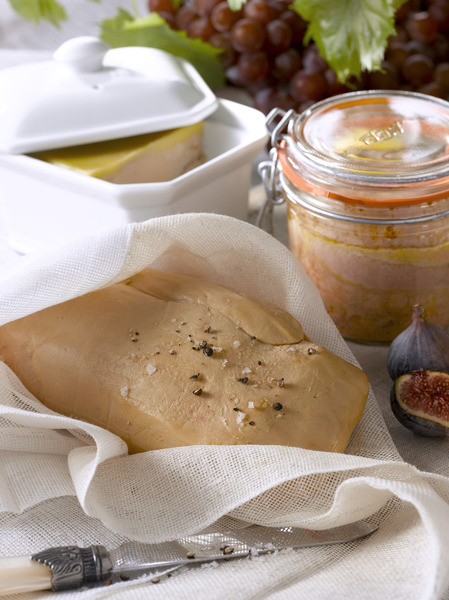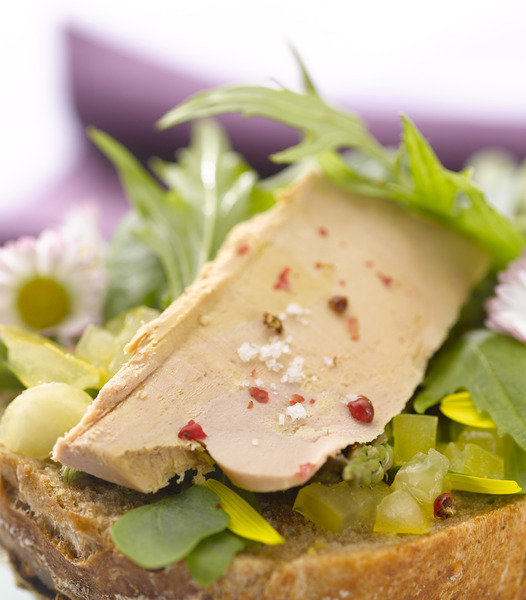Foie gras is a delicacy with a unique, refined taste.
 Foie gras is the liver of a goose or duck specially fattened through a feeding process for a specific period of time
Foie gras is the liver of a goose or duck specially fattened through a feeding process for a specific period of time
Fattening: the English translation of Gavage, which comes from the French word ‘gave’, originating in the ancient region of Picardie. Its meaning is crop, or gullet (‘jabot’, ‘gosier’ in French - XII century) and is based on the pre-Roman words (‘gaba’, ‘gava’, ‘gorge’, ‘gosier’ –throat and gullet in English) which may be of Gallic origins. (Littré)
The fattening of geese and ducks is based on the natural capacity of the liver of fat palmipeds to store large quantities of fat.
The process is entirely reversible and when an animal is given moderate amounts of food, their liver gradually returns to its normal size.
Well-known organoleptic and nutritional qualities
A perfect foie gras must be smooth, supple and firm to the touch. Its colour must be uniform. The shade will vary depending on the type of maize used for the fattening. Goose foie gras is generally a little pinker than duck foie gras.
More duck foie gras is eaten than goose foie gras. It’s more "rustic" with a stronger taste.
Its bold taste appeals to many gourmets and it now accounts for over 90% of French foie gras production.
Goose foie gras is delicate and sweet on the palate. Some gourmets find it more subtle than duck foie gras. But, it's all a matter of taste...
Goose and duck foie gras both consist primarily of good fats – poly and monounsaturated fatty acids - that are beneficial in the prevention of cardiovascular disease.
They also contain iron, vitamin A and vitamin B9 (folic acid) [see the REGAL composition table, 1995].
European and French regulations define foie gras as the liver of a fat palmiped (goose or duck) following a period of fattening.
Regulatory definitions
In Europe
According to European Commission regulation CE 1538/91 of 5 June 1991, a duck foie gras must weigh at least 300 g and a goose foie gras at least 400 g.
Download the regulation excerpt
In addition, following a European public investigation, European Council regulation CE 1338/2000 of June 2000 recognised the Protected Geographical Indication (PGI) "Canard à foie gras du Sud-Ouest" ("South-western foie gras duck").
This official quality label sets out the precise conditions under which ducks must be raised and fattened in the production area, the geographical boundaries of which are defined by shared historical practices.
Specifications define the exact characteristics of the foie gras sold with this quality label.
In France
The definition of foie gras and its production method are also included in Article L 654-271-1 of the Rural Code (Article 74 of the framework law of 5 January 2006):
« By Foie Gras one means a fattened duck or goose liver via specific fattening processes. »
The article also recognises the fattening technique as special know-how and states that foie gras is "part of the cultural and gastronomic heritage" of France.
Depending on its use (fresh or processed) the optimal weight of a duck foie gras is between 450 and 600 g and between 650 to 800 g for a goose foie gras.
Foie gras is a perfectly healthy product.
 When palmipeds eat food rich in starch - like maize - they transform carbohydrates into lipids, a significant portion of which is stored in their liver.
When palmipeds eat food rich in starch - like maize - they transform carbohydrates into lipids, a significant portion of which is stored in their liver.
The accumulation of fats in hepatic cells is called steatosis.
Steatosis is a normal physiological process when geese and ducks are force-fed because their livers are designed to store fat.
In humans, on the other hand, steatosis can be a sign of a pathology.
Steatosis isn't the same thing as cirrhosis. Cirrhosis entails the destruction of liver cells and their replacement by non-functional scar tissue.
Scientific studies have shown no degeneration of palmiped liver cells during or after fattening.
The accumulation of fat in the livers of geese and ducks is a natural and totally reversible biological process.
If a fattened palmiped is taken out of the fattening cycle, its liver will return to a normal weight and appearance. This is what happens in nature when a bird has exhausted its energy resources following a long migration.
A foie gras isn't a diseased liver, it's a healthy product.
